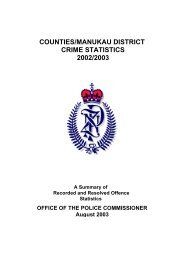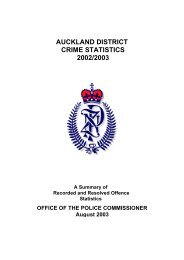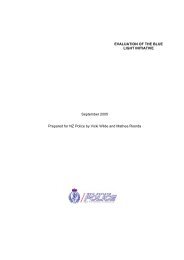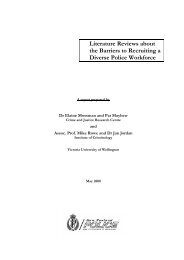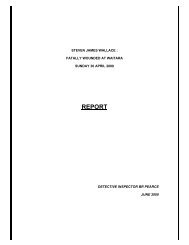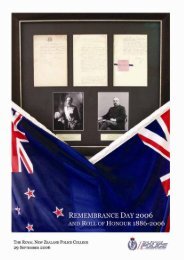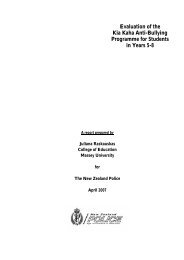Police Perceptions of Maori - Rethinking Crime and Punishment
Police Perceptions of Maori - Rethinking Crime and Punishment
Police Perceptions of Maori - Rethinking Crime and Punishment
You also want an ePaper? Increase the reach of your titles
YUMPU automatically turns print PDFs into web optimized ePapers that Google loves.
for <strong>Maori</strong> for non <strong>Maori</strong> Same Know<br />
% % % %<br />
Dealing with the general population 7 2 84 7<br />
Dealing with <strong>Maori</strong> <strong>of</strong>fenders 11 24 56 9<br />
Dealing with <strong>Maori</strong> victims 2 36 50 11<br />
Dealing with abusive comments<br />
about race or colour 34 4 50 13<br />
Dealing with deaths 41 9 39 11<br />
* Note: Percentages sum across rows. 'Don't Know' <strong>and</strong> 'No Responses' have been combined.<br />
Table 8 shows that there was overall agreement that dealing with the general<br />
population was equally easy or difficult for both <strong>Maori</strong> <strong>and</strong> non <strong>Maori</strong>. In dealing with<br />
<strong>Maori</strong> <strong>of</strong>fenders <strong>and</strong> victims, about half the respondents thought there was no<br />
difference but one in four said it was more difficult for non <strong>Maori</strong> to deal with <strong>Maori</strong><br />
<strong>of</strong>fenders <strong>and</strong> over a third thought it was more difficult for non <strong>Maori</strong> to deal with<br />
<strong>Maori</strong> victims. When dealing with abusive comments about race or colour, a half saw<br />
no difference but a third thought this was more difficult for <strong>Maori</strong> <strong>of</strong>ficers.<br />
And, <strong>Maori</strong> <strong>of</strong>ficers were seen as having greater difficulty in dealing with deaths by<br />
approximately 40% <strong>of</strong> respondents. Several respondents commented that it was hard<br />
for <strong>Maori</strong> to h<strong>and</strong>le situations involving a dead body. Some suggested that this was<br />
partly related to concerns about the need to respect <strong>Maori</strong> protocol when the death<br />
involved a <strong>Maori</strong> person. In contrast, the following quotes indicate some <strong>of</strong> the views<br />
about the advantages <strong>of</strong> being <strong>Maori</strong>:<br />
Knowledge <strong>of</strong> cultural issues, especially knowing <strong>Maori</strong> protocol about death,<br />
is important. This is especially so in working with <strong>Maori</strong> victims <strong>and</strong><br />
witnesses. It also makes for good communication in getting information that<br />
leads to solving <strong>of</strong>fences.<br />
Knowing whakapapa <strong>and</strong> tikanga can help you relate to people - it gives you<br />
an edge.<br />
<strong>Police</strong> <strong>of</strong>ficers' attitudes<br />
Two questions were designed to explore police <strong>of</strong>ficers' own views about <strong>Maori</strong>. The<br />
first group <strong>of</strong> 9 items asked about the extent respondents agreed with aspects <strong>of</strong><br />
current <strong>Maori</strong> aspirations. For technical reasons, responses to the second set <strong>of</strong> items<br />
have had to be discarded from the analysis. 12<br />
The responses to items reflecting possible <strong>Maori</strong> aspirations are listed in Table 9.<br />
12 The second set <strong>of</strong> 7 items were an attempt to parallel items from a scale developed in the US<br />
(the Modern Racism Scale; McConahay, 1986) which listed a number <strong>of</strong> items that might<br />
reflect the views <strong>of</strong> those opposed to <strong>Maori</strong> aspirations <strong>and</strong> which were, except for the first<br />
item, likely to be answered in the opposite direction from the first group. Although the spread<br />
<strong>of</strong> responses to the five point scale <strong>of</strong> agreement to these items was satisfactory, correlations<br />
between the two sets were mildly positive. This means that many <strong>of</strong> those who agreed to pro-<br />
<strong>Maori</strong> items also agreed to anti-<strong>Maori</strong> items. The only reasonable explanation for this is that<br />
many respondents continued to use the scale as if all the items were in the same direction <strong>of</strong><br />
positivity. Thus, the second set <strong>of</strong> seven items have been excluded from further analysis as the<br />
responses have to be regarded as unreliable.<br />
19



